When you put on yoga pants or tight denim jeans, you expect the clothes to stretch and fit the shape of your body. Blended fabrics add spandex or Lycra into your clothes to create this elasticity. This may leave you wondering if you compare Lycra vs spandex, what’s the difference?
Spandex and Lycra are both names for a material called elastane. Elastane is a synthetic fabric made out of stretchy elastomers that come from a polymer called polyurethane. Spandex and Lycra make clothing like leggings, underwear, hosiery, and swimwear more stretchy.
In this article, you’ll learn where spandex and Lycra come from. You’ll find out how revolutionary stretch fabrics shaped the clothing industry. Finally, you’ll discover common uses for spandex and Lycra.
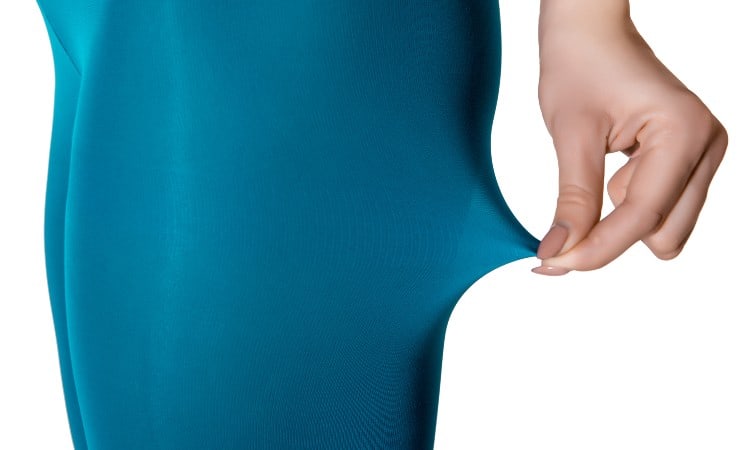
Lycra vs Spandex vs Elastane: What is the Difference?
Spandex and Elastane are different names for the same stretchy material, while Lycra is a brand name for the same cloth. If you see these terms used interchangeably, that’s because Lycra is spandex and spandex is elastane!
In case that sounded a bit like a riddle, here’s the run-down on the origins of each name.
During WWII, a German scientist named Otto Bayer developed polyurethane as a substitute for rubber. Nazi Germany wanted to use this material for coating fighter planes and other war-related projects. But they also incidentally created the stretchy elastomers that would become elastane.
After the war ended, a famous US company called DuPont ended up with this German research. Based on this, an inventor, chemist Joseph Shiver created Lycra in the late 1950s. DuPont called the fabric itself spandex but chose “Lycra” as a brand name to make the material popular.
Today, the material itself is often called spandex in the United States. This term cleverly hints at the word “expand.” The name spandex does not belong to any company as a trademark.
The name elastane also describes the elastic property of this fabric. The term elastane does not belong to a company as a trademark, either.
The name Lycra, on the other hand, belongs exclusively to DuPont. They use this brand name to market spandex in the United States.
So, what exactly is this stretchy fabric called elastane, spandex, or Lycra? Whatever you call it, this material begins life in a lab.
Like many synthetic fabrics, it goes through several intense chemical synthesis processes. These chemical reactions turn plastic into a wearable kind of cloth.
Without diving too far down the rabbit hole of scientific terms, here’s a brief look at the manufacturing process.
First, something called prepolymer forms when macroglycol mixes with a monomer called diisocyanate.The prepolymer then mixes with a reactive agent called diamine acid. This starts a dry spinning method, the safest way to produce elastane.
This liquid plastic solution spins in a container called a fiber production cell to develop elastomers. Then the solution squeezes out through a spinneret. When heated, this substance becomes solid fibers.
The fibers squeeze out through a nozzle that forces them into a special device that uses air to twist them into threads.
Typically, these stretchy threads get added to another material to make it more elastic, such as cotton or polyester. You don’t often see 100% elastane, Lycra, or Spandex!
What is Lycra Material
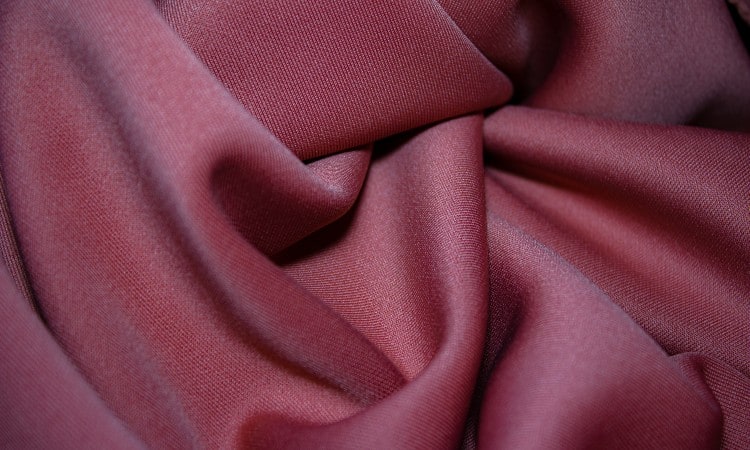
Lycra remains popular today as Dupont’s trademark brand name for spandex. If you check the label inside your leggings or tights, you will probably find that these garments contain a small percentage of Lycra or spandex. You may also see the word elastane or even other branded names such as Acepora, INVIYA, and Elaspan.
Whatever the name or brand, they all mean the same stretchy elastomer fibers blended into the fabric of your clothing.
Clothing usually contains less than 10% of these elastic fibers. On its own, 100% elastane can stretch five to eight times its original size! When blended into polyester, cotton, or wool, it adds just a touch of stretch or a nice form-fitting ability to these less-stretchy materials.
As a fun fact about Lycra, DuPont used a massive ad campaign to promote this modern replacement for rubber in clothing. The company enlisted famous actresses like Audrey Hepburn and Joan Collins to help with promotion!
Today, spandex/elastane/Lycra shows up in everything from underwear to sportswear to swimsuits.
What is Spandex Made Of?
Spandex, elastane, and Lycra are all names used to describe an elastic material made out of polyurethane.
Polyurethane has such versatility that you can find it in millions of different uses today. It’s pretty amazing to think that no one had invented this kind of plastic until WWII!
Today, polyurethane fills mattresses and provides insulation inside walls. It also mixes into paints and even makes roller blade wheels!
The invention of this adaptive plastic inspired the development of spandex. As you know from the previous section, making spandex involves altering polyurethane. It turns this plastic into elastomers through complex chemical synthesis.
The original invention of polyurethane had its roots in a wartime need for a replacement for rubber. In contrast, DuPont had peacetime and fashion in mind when they created spandex.
Women’s clothing at the time used stiff, uncomfortable rubber for things like girdles. Spandex massively revolutionized the way women wore clothing, especially undergarments!
Plus, DuPont wanted to save money and avoid depending on the natural resource of rubber trees. Like most synthetic fabrics, it costs a lot less to make spandex than it does to grow and harvest rubber trees.
Key Characteristics of Lycra, Spandex, and Elastane
Whether you call it Lycra, spandex, or elastane, this stretchy fabric has several special characteristics. These include its elasticity, its resistance to heat, and its durability.
Stretch
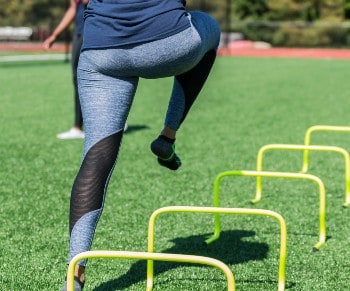 The unique characteristic of this material is its ability to stretch and return to its original size.
The unique characteristic of this material is its ability to stretch and return to its original size.
Think of a bungee jumper plunging off a tower. The cord stretches when the jumper reaches the end of the rope. Then the elastic cord snaps back into its original, shorter size, bringing the jumper back up to the top!
Interestingly, elasticity describes a material’s ability to resist stretch. This force is what yanks the jumper back to the top, as the elastic returns to its original shape!
That said, multiple factors make any given piece of cloth more or less stretchy. Woven cloth can stretch on the bias (diagonally) but not vertically or horizontally. On the other hand, knitted cloth has a lot of inherent stretch because of the way the threads loop together.
For this reason, adding spandex to a knitted fabric will create a super-stretchy material. Adding spandex to a woven material will give it a little stretch but not so much.
The amount of stretch depends on the characteristics of the other fabric in the blend, too.
This shows that while elastane, spandex, and Lycra have amazing elasticity in their pure form, the amount of stretch varies when they get added into another kind of material.
Breathability
Spandex has no breathability. Fortunately, manufacturers typically blend a tiny percentage of spandex into other materials.
These materials, like cotton, do have some natural breathability. This offsets the moisture-trapping, body-heat sealing properties of spandex!
You certainly wouldn’t want to go for a jog wearing a pure spandex t-shirt! Instead, popular athletic wear blends cotton and spandex, polyester and elastane, and nylon and Lycra.
As a pro tip, look for looser weaves or knits when you want more breathable sportswear. The tiny gaps between threads will allow for great airflow.
Also, many synthetic fabrics like polyester provide moisture-wicking. This means that the fabric will suck away your sweat and allow it to evaporate into the air!
Sustainability
You can find varying opinions on whether or not spandex is a sustainable material. The invention of elastane did seriously cut back on the harvesting of rubber. Rubber plantations unquestionably cause serious environmental harm, so this is a plus!
On the other side of the argument, producing spandex requires the use of lots of toxic chemicals. Disposing of these chemicals can also harm the environment.
Ideally, companies follow strict guidelines around this disposal. But the chemicals still exist even when safely stored away.
Then, of course, there is the issue that spandex can’t biodegrade, meaning that it can also contribute heavily to plastic pollution.
That said, you would find it difficult to take a principled stance against spandex. It isn’t easy to find clothes that don’t contain at least a little of these so-important elastic fibers!
Durability
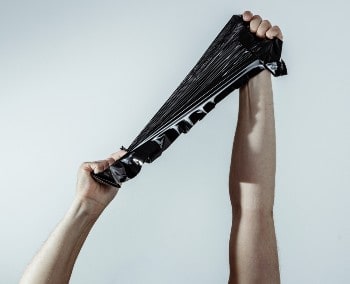 Spandex has quite an impressive durability. It has greater strength and more stretch than rubber. It can lose its elasticity over time, though proper care will delay this process.
Spandex has quite an impressive durability. It has greater strength and more stretch than rubber. It can lose its elasticity over time, though proper care will delay this process.
In terms of longevity, Lycra and spandex can outlast anything but another kind of plastic. It also has great resistance to body oils and perspiration, making it easy to keep fresh-smelling!
Of course, outside forces like too much exposure to heat or improper care can eventually damage these materials.
Warmth
On its own, spandex does not provide much insulation. Twisting spandex fibers with the thicker, softer polyester fibers or cotton will create a warm and stretchy fabric, though!
Spandex will never compete with cotton or acrylic cloth for warmth. Spandex is just too thin to insulate you!
Despite that, you can put spandex to good use on cold days by using a spandex blend garment as a base layer. A good base layer rests snug against your skin to seal in as much heat as possible, so you need fabric that contains a good stretch for this purpose!
You can then add a middle layer and an outer windbreaker layer to complete your warming outfit.
Softness
Lycra doesn’t feel soft like down feathers or pima cotton. But it does have a smooth, light silkiness to it.
When added to other fabrics, it doesn’t add any weight or coarseness to the mix. Instead, it tends to make these blends feel a little lighter and silkier.
As a bonus, spandex resists pilling, so it can also keep your clothes looking like new for much longer!
Cost
Spandex typically costs more than other synthetic fabrics like polyester and nylon. It has a more involved production process.
But manufacturers also only use a tiny percentage of spandex in most retail clothing. This means that the price of spandex rarely heavily impacts clothing costs.
If you plan to buy stretch fabric by the yard, you can expect to pay around ten to twenty dollars per yard for this kind of sportswear fabric.
Care
Most stretch wear can safely go in the washer. You should turn the garment inside out for best results and place it in a mesh laundry bag to prevent any snagging threads during the wash cycle. Use cool water and a gentle wash cycle.
Some types of spandex or Lycra may require special detergents, so make sure you read the label inside the garment before washing.
As with most stretchy things, heat can break down the elasticity of this material. Avoid placing clothes that contain elastane in the dryer. Instead, air dries them for best results.
Popular Uses
Spandex shows up in so many kinds of clothing that it would almost be easier to list the clothes that don’t use this stretchy material!
Any kind of form-fitting clothing almost certainly contains elastane. This includes clothing like underwear, hosiery, swimwear, and even motion-capture suits.
A hundred years ago, people had to tie ribbons around their stockings to hold them up. Today, the spandex in your socks keeps them from flopping down around your ankles!
A lot of athletic wear also uses a blend containing spandex for ease of movement. Bicycle shorts and running tanks almost always include elastic fibers to make them more comfortable.
Even if your clothes don’t contain that much Lycra or spandex, any stretch waistband probably does!
Advantages and Disadvantages of Spandex, Lycra, Elastane
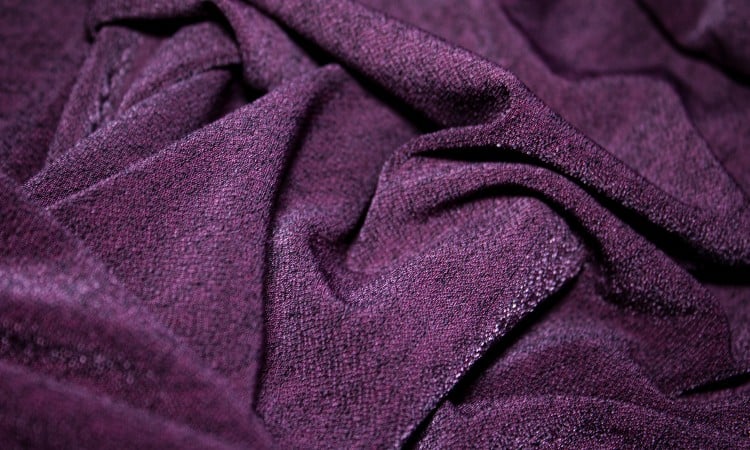
Like all synthetic materials, spandex/Lycra/elastane comes with some advantages and disadvantages.
The biggest advantage, of course, is its stretchiness! It also resists abrasion, doesn’t pill, and has a soft, supple feel. It does not hold onto body odor or oil-based smells, and it has greater strength than rubber.
On the downside, it costs more than most other synthetic fabrics. It uses toxic chemicals during its manufacturing process. Its lack of breathability can cause skin allergies in some situations.
Finally, both heat and chlorine can easily damage the elasticity of the fabric as well.
Why is Lycra or Spandex Blended in Fabric?
 Blending spandex into another fabric such as cotton or polyester makes it possible to create form-fitting clothing that allows easy movement. Because of this, the invention of elastane completely reshaped the world of fashion. (No pun intended, wink-wink!).
Blending spandex into another fabric such as cotton or polyester makes it possible to create form-fitting clothing that allows easy movement. Because of this, the invention of elastane completely reshaped the world of fashion. (No pun intended, wink-wink!).
Yoga pants and pretty much the whole athleisure category wouldn’t exist without spandex. Bicycle shorts and sports bras couldn’t give proper support without elastic fibers woven into them. Changing underwear styles also owe their much more comfortable fit to spandex!
Other form-fitting sportswear like gymnastics leotards and swimsuits also uses elastane.
Stretch denim first saw the light in 1978 when a London fashion designer reimagined the world of jeans. In the 1980s, stretch jeans had quite a sexy advertising campaign promoted by brands like Calvin Klein and Jordache. This made stretch jeans a staple of many modern wardrobes to this day!
Most stretch jeans contain only 1% to 3% of elastane in the blend. Even this tiny amount allows the denim to hug your curves, though!
Remember, you may find jeans that say they contain Lycra, spandex, or elastane, but it’s all the same thing!
Spandex vs. Elastane vs. Polyester vs. Nylon
Polyester, nylon, and elastane all come from a chemical synthesis process. Despite that, each fabric has unique characteristics.
The most obvious difference is that polyester and nylon don’t stretch. Or at least, polyester and nylon fibers do not have any elasticity. Knits made of polyester or nylon could have some stretch.
Spandex, on the other hand, has an excellent stretch and recoil!
When you get down to the nuts and bolts of it, each of the three types of material have different building blocks, too. They start from different monomers and undergo slightly different chemical reactions before becoming fibers.
Polyester and nylon both have greater durability and versatility than spandex. Even though elastane gets blended into many different kinds of clothing, it’s kind of a one-trick pony. The clothing industry uses it almost exclusively for its elasticity.
Polyester and nylon, in contrast, have many uses. These range from looking pretty to protecting from the weather to keeping you warm.
Popular Uses of Lycra and Spandex

Some of the most popular Lycra, spandex, and elastane uses include leggings, stretch denim, swimwear, underwear, tights, and socks.
Something like 80% of all retail clothing contains elastane fibers. Despite that, you can still narrow this massive use down to a few of the most popular types of clothing that depend on that nice elastic stretch!
Keep in mind that modern manufacturers allow for the added stretch in these types of clothes, so just buy your normal size! You don’t need to buy bigger or smaller, thinking that the stretchiness will make the clothes fit you differently.
Leggings
 Leggings usually refer to skin-tight, soft pants that hug your legs but don’t cover your feet like tights. You can sometimes wear leggings on their own, though certain styles have a sheer quality that makes them better suited for wearing with a long shirt or tunic.
Leggings usually refer to skin-tight, soft pants that hug your legs but don’t cover your feet like tights. You can sometimes wear leggings on their own, though certain styles have a sheer quality that makes them better suited for wearing with a long shirt or tunic.
You may also confuse leggings with yoga pants, which typically flair out more at the ankle, though they may fit tightly in the seat and hips.
Almost all leggings and yoga pants contain some blend of elastane to make them stretchy and form-fitting.
Check out these cozy leggings with a 12% spandex blend!
Tights
 Tights may look similar to leggings, but they usually cover both your legs and your feet with skin-hugging, often sheer fabric. They pair well with a long sweater, dress, or skirt.
Tights may look similar to leggings, but they usually cover both your legs and your feet with skin-hugging, often sheer fabric. They pair well with a long sweater, dress, or skirt.
For hundreds of years, fashion dictated that ladies (and sometimes men as well!) wear silk stockings held up by garters. The invention of elastane made those loose, scrunch stockings and annoying garters unnecessary!
Today, opaque tights and sheer nylon stockings contain stretchy elastane that keeps the fabric tight against your legs.
You can buy tons of different types of tights, but take a look at this stylish pair that contains 13% elastane!
Stretch Denim
 Stretch jeans make anyone’s legs look good! Unlike the traditional stiff, rather a clunky style of old-fashioned denim, stretch denim has a thinner and softer texture. These jeans hug the line of your legs and set off all your curves to a good advantage!
Stretch jeans make anyone’s legs look good! Unlike the traditional stiff, rather a clunky style of old-fashioned denim, stretch denim has a thinner and softer texture. These jeans hug the line of your legs and set off all your curves to a good advantage!
You can buy stretch jeans in lots of different styles, from boot cut to slim-fit. These jeans also pair well with all kinds of outfits. You can go casual with tight jeans and a t-shirt, or dress things up with a silky blouse, heels, and your killer jeans!
You can also buy stretch denim that contains more or less spandex for a varying amount of stretchiness. The manufacturer’s label or product description should tell you what percentage of the total fabric is elastane.
For example, check out this classy pair of stretch jeans that features 2% spandex!
Swimwear
 Whether you like bikinis or wetsuits, you depend on the elastic in your swimwear to hold everything in its proper place!
Whether you like bikinis or wetsuits, you depend on the elastic in your swimwear to hold everything in its proper place!
The invention of nylon and polyester also dramatically shaped the development of modern swimwear. Before these synthetic fabrics hit the market, wool was the only fabric people knew of that had good water resistance. This meant that people would go to the beach clothed head-to-toe in wool!
Today, nylon or polyester blended with some nice, stretchy spandex gives you water-resistant, form-fitting swimwear that looks good and keeps you cool!
Though your personal style no doubt dictates the kind of swimsuit you prefer, take a look at this bathing suit just to get an idea of how much spandex swimsuits often use!
Underwear
 While you can buy 100% spandex underwear, most modern styles contain just enough spandex to give you a comfy fit. Pure spandex or nylon doesn’t offer enough breathability to be very comfortable after a while.
While you can buy 100% spandex underwear, most modern styles contain just enough spandex to give you a comfy fit. Pure spandex or nylon doesn’t offer enough breathability to be very comfortable after a while.
That said, almost all modern underwear styles, for both women and men, contain at least some elastane. If nothing else, the stretchy waistband will!
Perhaps more than any other kind of clothing, underwear styles have changed dramatically because of the invention of stretchy fabric. Instead of baggy bloomers, you can now choose from dozens of styles, from boxers to bikini cuts!
Check out this casual style that contains 5% spandex!
Socks
 Spandex gives your socks a snug fit. Typically, a blend of spandex and cotton or spandex and polyester creates light, breathable, stretchy socks!
Spandex gives your socks a snug fit. Typically, a blend of spandex and cotton or spandex and polyester creates light, breathable, stretchy socks!
Keep in mind that you can buy several different styles of socks for different activities. For example, you can get those little footsies to go inside your ballet flats or thick hiking socks for braving the outdoors!
Each style of the sock does better with different kinds of material. For hiking socks, you might want wool or acrylic blended with spandex. For dress socks, nylon or cotton blended with spandex might look nice.
Take a look at this set of practical socks that contains cotton, polyester, and 3% spandex!
Conclusion
Spandex, elastane, and Lycra all describe the same material made from polyurethane. This synthetic fabric has amazing elasticity. You will often find a blend of spandex and another non-stretchy fabric in your comfortable, form-fitting clothing.
Spandex and Lycra have many common uses, including leggings, underwear, and swimwear.
Tights, socks, and stretch jeans also fit more comfortably with the addition of elastane!
What kind of stretchy clothing do you like to wear? Maybe you have a favorite pair of leggings or an awesome swimsuit! Leave a comment below to let us know!